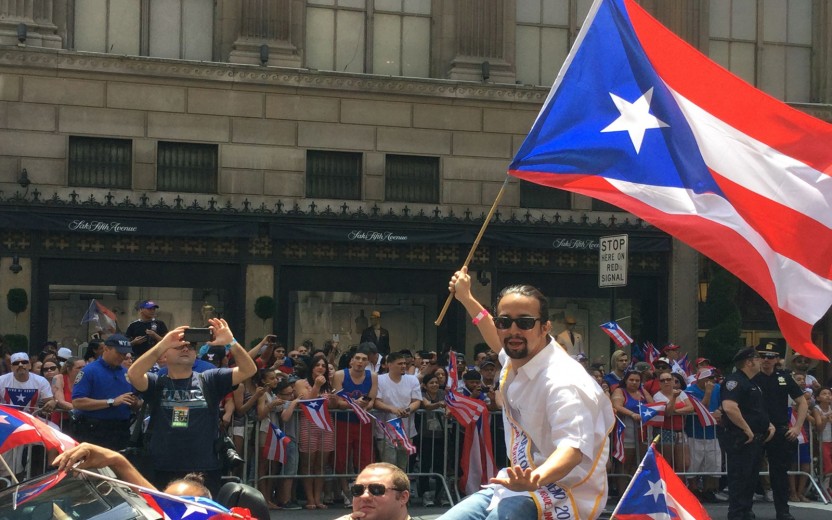It’s June, which means only one thing for many Latinos in New York City – the National Puerto Rican Day Parade. I grew up with the parade. As a child in the Bronx I was a drummer in a neighborhood “Batutera” band playing Latin beats as young girls with batons and pom-poms performed choreographed dances while marching in formation. When I was in college, I marched with my fraternity. Funny enough also doing choreographed dances while marching in formation – but we called them strolls. The parade has been a part of the summer in New York for as long as I can remember.
With the floats, music, the endless dancing and revelry, the National Puerto Rican Day Parade is the largest parade in New York City. Yes, that’s right, bigger than St. Patrick’s and bigger than Columbus Day. Given that the parade has spanned generations, its also seen significant changes, and as is typical of many things Latino, it’s fair share of drama. With the parade set to drop soon we thought it an appropriate to travel through time and look at some of its most historical and dramatic moments.
1955
The Hispanic Day Parade
Surprise! While many will state (including the National Puerto Rican Day Parade Website) that the parade started in 1958, The Puerto Rican Day Parade can actually find its origins in the Hispanic Day Parade started by the Federation of Hispanic Societies, which included various Puerto Rican activist organizations. The idea and mission for the parade was to foster Latino unity amongst various Latin American immigrants, struggling to make it in the big apple.
1957
Puerto Ricans separate from the Hispanic Day Parade
The 1950’s also saw unprecedented growth of the Puerto Rican population in the New York City. This was the beginning of what was called the “Great Migration,” with over 1 million Puerto Ricans coming to New York during this period. Perhaps because the population was growing so fast, or because of various pressures and internal battles within the organizations that produced the Hispanic Day Parade, some Puerto Rican groups decided to break off and create their own parade. During the first few years there were two parades held as separate, competing events. Then in 1958 The Puerto Rican Day Parade became the prominent parade of the summer. The Hispanic Day parade would re-emerge in NYC in September/October during Hispanic Heritage month.
1967
The Revolution Is Televised
Proving its power, popularity and reach. In 1967 the Puerto Rican Day Parade is televised for the first time on the Telemundo network (that’s channel 47 for old the old school folk). That year would begin a run over the next 29 years, where it then moved to English-language TV in 2007!
1995
The Parade Goes National
The parade had always included local delegations from the tri-state area, various regions of the United States and of course la isla del encanto itself, but in 1995, they officially transitioned from a New York City parade to a National one, claiming 100,000 participants, and delegations from all the towns of Puerto Rico and all 50 states! It would now be known to one and all as the National Puerto Rican Day Parade.
1998
The Seinfeld Incident
During a prime time episode of the hit show “Seinfeld,” the main characters become “stuck” in the middle of the Puerto Rican Day Parade while trying to flee the city. One of the characters proceeds to to burn a Puerto Rican flag — by mistake, and then stomp on it to get the flames out. That, and the various negative images of Puerto Ricans portrayed in the episode, led many to protest the show, to the point where it’s broadcasting parent took the episode out of syndication.
2000
Assault in Central Park
Perhaps the lowest point during the long and mostly peaceful history of the parade, a group of women were groped and assaulted while in Central Park by various bands of men after the parade had let out. Many people believe that the incident was more about city mismanagement of the largest parade of the year, having corralled tens of thousands of people from walking down the streets of the Upper East Side, instead relegating them to the park with a minimal police presence.
2014-2015
The Investigation and a New Era
2014 was a pivotal year, as an investigation of fiscal mismanagement by parade organizers lead to reorganization and refocusing of the parade and it’s mission. This came after a few years of very poor decisions by the parade board, including selecting a Parade Marshal who was a convicted domestic abuser and signing sponsorships with companies that the public deemed inappropriate. This decision-making led to further inquiry as where the funds for sponsorships were actually going. A public outcry for new leadership arose. New leadership was assembled including the likes of including Lorraine A. Cortés-Vázquez, former chair of the Hispanic Federation and former NYC Secretary of State.
This year’s theme is “One Community, Many Voices,” and is honoring cultural legends like actor/singers Rita Moreno, Victor Manuelle, and looking towards the future by honoring Lin Manuel Miranda, creator of Broadway hits In The Heights and Hamilton.
The parade is indeed at a crossroads, and the people are hopeful that the new leadership will steer clear of controversy and focus on core values such as education, culture and the achievements of the people the parade represents. There are much more “key moments” to come, and we look forward to many more years of this parade, as it helps shape what is New York and the country as a whole.

